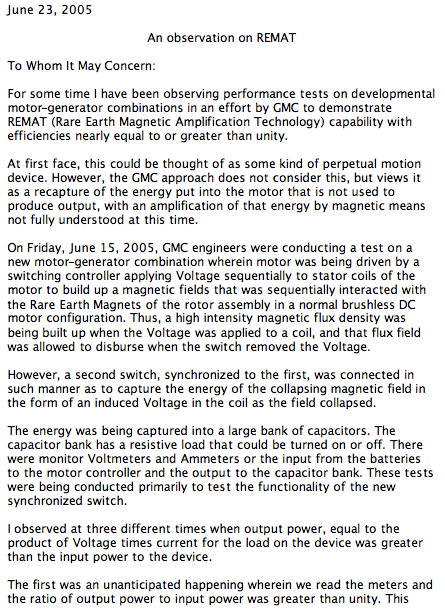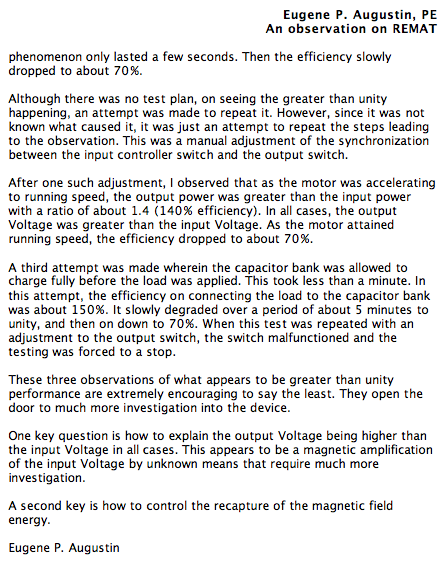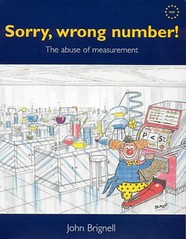GMCC REMAT Part 2: Lee M Webb Interview
Lee M Webb interviewed GMCC President Bruce McKenzie for an article in Stockwatch. Lee put portions of the interview into the public domain.
Since 2004, the company has claimed to have a self-powered motor that represents the Solution For The World's Power and Energy Needs. The company even published a report by an engineer supporting their claims of a breakthrough, which we discussed in part 1. Indented items below are quotes from Webb's interview. I have edited his quotes for formatting and to add links not part of his article.
What does the company say?
When asked about the company's earlier claims about the greater than unity observations, Mr. McKenzie attempted to put some distance between GMC's current focus and that topic.
"The greater than unity tests were all visual," Mr. McKenzie said. "They were not double-blinded or triple-blind studied by engineers."
GMC's president said the phenomenon was observed and the company has to take responsibility for the news release; nonetheless, he was clearly not comfortable with those claims.
"The world we're in is not truly trying to be over unity and those words -- perpetual motion, over unity -- those are not the claims I would like to see the company's direction," Mr. McKenzie said. "That's why you haven't seen any more of that.
"Richard Brace is the CEO and I'm the president and we've got more reality from engineering groups that have educated some of the marketing people around here."
According to Mr. McKenzie, part of that education involved making clear that claims about the technology had to be run by "an educated source" before news releases were issued.
"It was lax on our part with some engineers that interpreted (the test observations) and there was a marketing guy standing around -- he's no longer with us -- and he took it and ran with it before anybody could control it," Mr. McKenzie said.
According to Mr. McKenzie, the company plans to issue a series of properly vetted news releases soon, but investors will not hear anything about over unity devices from him.
While Webb finds that the company shied away from its claims of a self-powered motor in his interview, the claims are still on their website. The "marketing guy" who is no longer with them most likely refers to William Windsor, who is still on the officers list for GMCC and another company, MOGENIX, INC. with GMCC CEO Richard Brace. William J Windsor has by means of default judgement been made subject to an SEC enforcement action over the "prime bank" high yield investment scheme The Gateway Association. The SEC complaint states that Windsor was also has six state securities fraud convictions for defrauding investors and a federal conviction for money laundering.
Webb asks also about the mobile lab announced in September.
What about the mobile lab?
GMC's president was asked what had become of the mobile lab that the company claimed was being constructed and equipped to demonstrate the REMAT motors last September.
"Actually, that was not necessary because the people showed so much interest that we didn't have to put a road show on the road to go pursue our end buyers," Mr. McKenzie said.
"We have three or four people to the table right now that are interested," he continued. "They've flown in, they've brought their engineers in and we're negotiating now with one of those buyers."
The buyers refers to the announcement by GMCC that this motor that powers itself (but you didn't hear it from him) has attracted attention form fortune 500 companies (but you wont hear it from them) and that GMCC plans to sell it and pay a dividend to its shareholders.
What about the price tag?
Mr. McKenzie was then asked about the $350-million to $500-million price tag suggested in the news release.
"We've had verbal evaluations on our technology and now we're actually going to have meetings in the next two days for written validation and confirmation of those numbers," GMC's president replied.
What about the audit?
Turning to some earlier news releases, Mr. McKenzie was asked about the status of the company's audit, which was announced last August.
"Well, that auditing firm has been tied up with a lot of other large business firms here and we are in negotiations with them to pass it off to another firm that can give it more time," Mr. McKenzie explained. "We're trying to accelerate that picture more than we are to dead-end the picture.
"We've interviewed two other firms already and we're thinking about transferring the work to these other two firms.
"Hopefully we'll have all our auditing done in the next three to four weeks."
End buyers?
Mr. McKenzie was asked whether GMC had produced or sold any of the motors.
"We're an R and D firm and we're preparing to license a few entities that have the infrastructures to take our technology to the marketplace, if they desire," Mr. McKenzie said.
"We're discussing licensing here, not manufacturing," he added.
"We haven't signed up with anyone, yet," Mr. McKenzie replied when asked whether the company had any licensees.
This should be our antepenultimate article on GMCC. We'll check back in a month to see how those meetings with buyers went, how the audit has progressed, and if the company has removed the overunity claims from its website now that its president says that investors will not hear anything about over unity devices from him.



